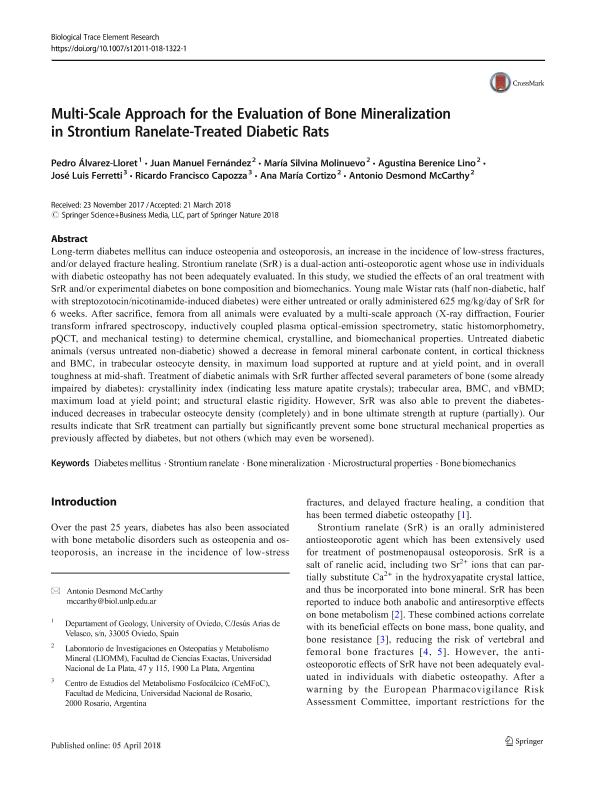Artículo
Multi-scale approach for the evaluation of bone mineralization in strontium ranelate-treated diabetic rats
Álvarez Lloret, Pedro; Fernández, Juan Manuel ; Molinuevo, María Silvina
; Molinuevo, María Silvina ; Lino, Agustina Berenice
; Lino, Agustina Berenice ; Ferretti, José Luis; Capozza, Ricardo Francisco
; Ferretti, José Luis; Capozza, Ricardo Francisco ; Cortizo, Ana María; McCarthy, Antonio Desmond
; Cortizo, Ana María; McCarthy, Antonio Desmond
 ; Molinuevo, María Silvina
; Molinuevo, María Silvina ; Lino, Agustina Berenice
; Lino, Agustina Berenice ; Ferretti, José Luis; Capozza, Ricardo Francisco
; Ferretti, José Luis; Capozza, Ricardo Francisco ; Cortizo, Ana María; McCarthy, Antonio Desmond
; Cortizo, Ana María; McCarthy, Antonio Desmond
Fecha de publicación:
04/2018
Editorial:
Humana Press
Revista:
Biological Trace Element Research
ISSN:
0163-4984
Idioma:
Inglés
Tipo de recurso:
Artículo publicado
Clasificación temática:
Resumen
Long-term Diabetes mellitus can induce osteopenia, osteoporosis, an increase in the incidence of low-stress fractures and/or delayed fracture healing. Strontium ranelate (SrR) is a dual-action anti-osteoporotic agent whose use in individuals with diabetic osteopathy has not been adequately evaluated. In this study, we studied the effects of an oral treatment with SrR and/or experimental Diabetes on bone composition and biomechanics. Young male Wistar rats (half non-diabetic, half with streptozotocin/nicotinamide-induced Diabetes) were either untreated, or orally administered 625mg/kg/day of SrR for 6 weeks. After sacrifice, femora from all animals were evaluated by a multi-scale approach (X-ray diffraction, Fourier transform infrared spectroscopy, inductively-coupled plasma optical-emission spectrometry, static histomorphometry, pQCT and mechanical testing) to determine chemical, crystalline, and biomechanical properties. Untreated diabetic animals (versus untreated non-diabetic) showed a decrease in femoral mineral carbonate content, in cortical thickness and BMC, in trabecular osteocyte density, in maximum load supported at rupture and at yield point, and in overall toughness at mid-shaft. Treatment of diabetic animals with SrR further affected several parameters of bone (some already impaired by Diabetes): Crystallinity Index (indicating less mature apatite crystals); trabecular area, BMC and vBMD; maximum load at yield point and structural elastic rigidity. However, SrR was also able to prevent the Diabetes-induced decreases in trabecular osteocyte density (completely) and in bone ultimate strength at rupture (partially). Our results indicate that SrR treatment can partially but significantly prevent some bone structural mechanical properties as previously affected by Diabetes, but not others (which may even be worsened).
Archivos asociados
Licencia
Identificadores
Colecciones
Articulos(CCT - LA PLATA)
Articulos de CTRO.CIENTIFICO TECNOL.CONICET - LA PLATA
Articulos de CTRO.CIENTIFICO TECNOL.CONICET - LA PLATA
Citación
Álvarez Lloret, Pedro; Fernández, Juan Manuel; Molinuevo, María Silvina; Lino, Agustina Berenice; Ferretti, José Luis; et al.; Multi-scale approach for the evaluation of bone mineralization in strontium ranelate-treated diabetic rats; Humana Press; Biological Trace Element Research; 4-2018; 1-10
Compartir
Altmétricas



